Botany Through Books: Example Projects
The examples featured in this section demonstrate the interdisciplinary collaboration of three librarians, each engaging with special collections artifacts through the lens of their distinct expertise. By treating unique items—such as the Badianus Manuscript, rare botanical atlases, and archival field notebooks—as primary sources, each librarian designed a project that transformed these historic materials into resources for active learning, community engagement, and scholarly communication.
In these projects, the librarians highlighted how special collections can support a range of student skills and authentic assessments. Collectively, these examples showcase the creation and sharing of knowledge in action: they illustrate how primary sources can be synthesized across subject areas, equipping agriculture students with opportunities to develop technical, research, and communication skills aligned with real-world applications.
Project One
Project prompt: Use the selected primary sources from the library’s special collections. Study each artifact to understand its role in the creation and sharing of scientific knowledge: consider how collaboration, individual observation, and adaptation for new audiences have shaped the ways information is recorded, interpreted, and communicated. Create a visual or digital project (e.g., infographic, digital handout, multimedia presentation) that synthesizes these primary sources. Your project should illustrate the diverse approaches to knowledge creation found in each resource and analyze how each contributes to documenting, preserving, and sharing botanical information.
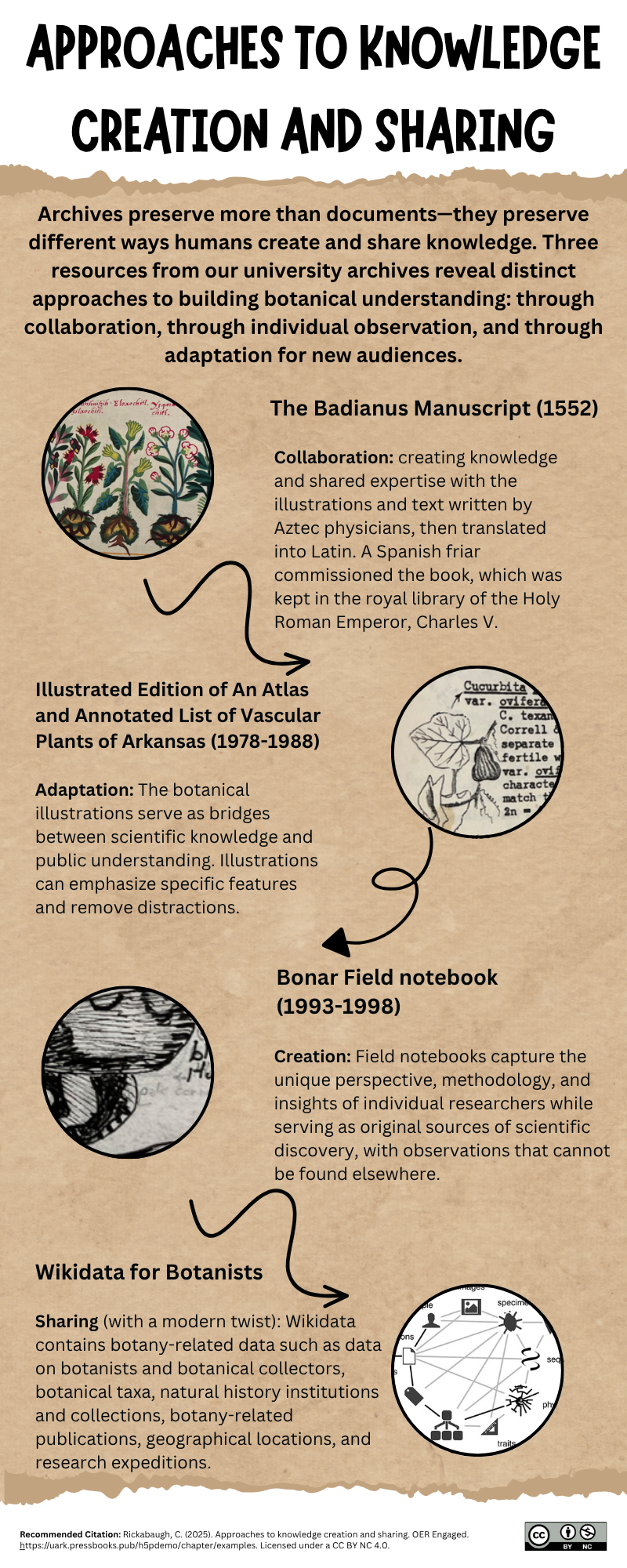
Project Two
Writing Prompt: Give a brief description of each item and how they connect to one another.
The Badianus Manuscript, 1552 (Facsimile Edition, 1940)
RS169.C7 1552a
This illustrated manuscript was the first herbarium to come out of the Americas. The original manuscript was discovered quite by accident in the Vatican Library by a Columbia University professor in the early 20th century. The illustrated Latin manuscript was titled Libellus de Medicinalibus Indorum Herbis or A Book of Medicinal Indian Herbs in English and was completed in 1552. The manuscript is now more commonly known as the Codex Cruz Badianus or the Badianus Manuscript, for both the author and translator. It contains 185 illustrations of plants with text that describes their medicinal uses. The drawings were completed by indigenous artists, and the text was written and translated by two indigenous faculty members of the Colegio Imperial de Santa Cruz at Tlatelolco, established in 1536 to train sons of the Aztec nobility for the clergy. Martin de la Cruz and Juan Badiano (Juannes Badianus in Latin) whose Spanish names were conferred upon their baptism. Martin de la Cruz was the Colegio’s indigenous doctor who gave instruction in medicine, and Juan Badiano, a Latin teacher and former student, translated the book into Latin.
The herbal dedicated to the Viceroy Francisco de Mendoza was sent to Spain as a gift to King Carlos I, soon after its completion in 1552. The original ended up in the Vatican Library until 1990, when then Pope John Paul II returned it to Mexico[1].
The original manuscript was created completely by hand, both the drawings and the text.
Historia plantarvm. : Earum imagines, nomenclaturae, qualitates, & natale solum. Accessere simpliciũ medicamentorum facultates, secundum locos, & genera ex Dioscoride. (1567)
QK41.D8
The title in English would translate to, “History of plants: Their images, nomenclature, qualities, and native soil. Access to the faculties of simple medicines, according to places and genera from Dioscorides.”
This was one of the earliest herbals in small pocket print format, compiled by a French translator, Antoine Du Pinet from the work of the botanist, Pietro Andrea Mattioli. Mattioli was a prolific commentator on De Materia Medica (On Medial Matter) of Dioscorides, a 5 volume Greek encyclopedia on herbal medicine from 1st century. Mattioli constantly updated his work and put out new editions, ensuring that his commentary was used well into the 18th century.
The plants are arranged alphabetically, with a woodcut per plant and their names listed with further details on location and ‘qualities’. The woodcut images have been rudimentary colored in using only about 2-3 pigments[2]
This print book has been added to and republished with original illustrations that enhance the book, as well as tell a different story than either part could tell alone.
Project Three
Assignment Prompt: Use one primary source from special collections and one peer-reviewed article to design a community outreach initiative. Create a digital handout in Pressbook format that describes the event and explains how you synthesized your sources to develop the outreach program. Include a list of skills demonstrated in your project. The handout may feature photos, sample guest experiences, and other relevant visuals.
Beyond the Resume: Showcasing Technical Skills Through Science Communication
As an Agriculture Librarian supporting students engaged in skills-based learning and evidence synthesis, I examine these primary sources from the perspective of a STEM student aiming to showcase their skills in a pressbook.
Example 1: In partnership with a local art museum, the student helps curate a rare book exhibit on botanical texts and writes interpretive labels highlighting their historical significance.
Primary Source: The Badianus Manuscript, 1552 (Facsimile Edition, 1940)
RS169.C7 1552a
Peer-Reviewed Source:
Assignment Entry:
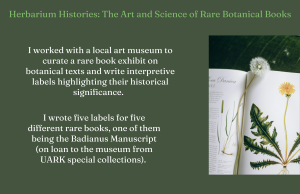
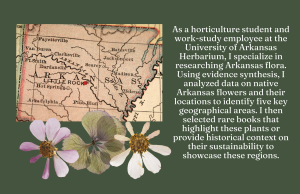
Skills Highlighted:
- Curation and Exhibition Design, including label writing
- Collaboration
- Historical Research
- Visual Literacy
Example 2: Student hosts a tabling for the Entomology and Plant Pathology department at the local botanical garden and distributes field guides to visitors.
Source: Kent Bonar Materials Addendum, Field Notebook with illustrations (1993-1998)
MC 1665a
Peer-Reviewed Source:
Assignment Entry:
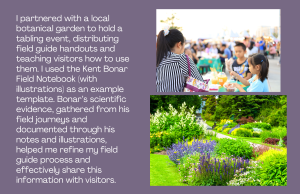
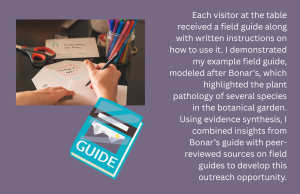
Skills Highlighted:
- Public Engagement and Program Planning
- Science Communication
- Community Relations
Example 3: Student uses research on climate change impacts to create an infographic that is distributed to the campus sustainability office.
Source: Arkansas Native Plant Society Records (1980-1983)
MC 932
Peer-Reviewed Source:
Assignment Entry:
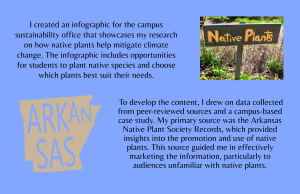
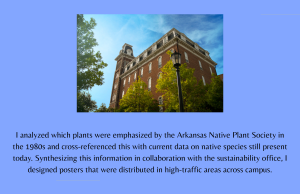
Skills Highlighted:
- Data Visualization
- Graphic Design
- Information Literacy
- Audience Targeting
- Environmental Research
- Salisbury, S. (n.d.). LibGuides: Art and History of Colonial Latin America: Badianus Manuscript. Retrieved August 20, 2025, from https://libguides.utsa.edu/c.php?g=454948&p=8612608 ↵
- Grout, J. (n.d.) Pier Andrea Mattioli. In Encyclopaedia Romana. University of Chicago. https://penelope.uchicago.edu/~grout/encyclopaedia_romana/aconite/mattioli.html[/footnote].
Unlike the Badianus, this book was created using a printing press for the text, and woodcut prints for the illustrations.
Illustrated edition of An Atlas and Annotated List of Vascular Plants of Arkansas (1978)
Kent Bonar Materials Addendum- MC 1665a
An Arkansas florilegium: the atlas of botanist Edwin Smith (2017)
QK148.S64 2017
The atlas compiled originally by Edwin Smith was added to by Kent Bonar, a State Park naturalist who has been illustrating the flora and fauna of Arkansas since 1972. Bonar carried a copy of Smith’s book along on hikes in various parks and rambles through the woods surrounding his Newton County home, entering hundreds upon hundreds of meticulous illustrations into Smith’s work. The original has become so fragile, one too many spills in the Arkansas River, that is currently stored unbound. In 2017, the University of Arkansas Press published An Arkansas Florilegium, which was the original Atlas and Annotated List of Vascular Plants of Arkansas with the addition of Bonar’s nearly 3,500 original illustrations. Along with Bonar’s original illustrated Atlas, you can also study his field notebooks that he used to create his illustrations[footnote]King, M. (2017, November 29). New UA Press book combines lifelong work of botanist, naturalist. Arkansas News. https://news.uark.edu/articles/40388/new-ua-press-book-combines-lifelong-work-of-botanist-naturalist ↵

